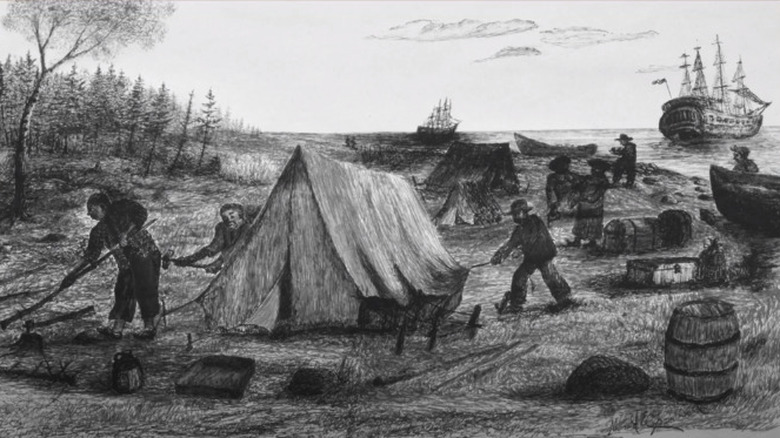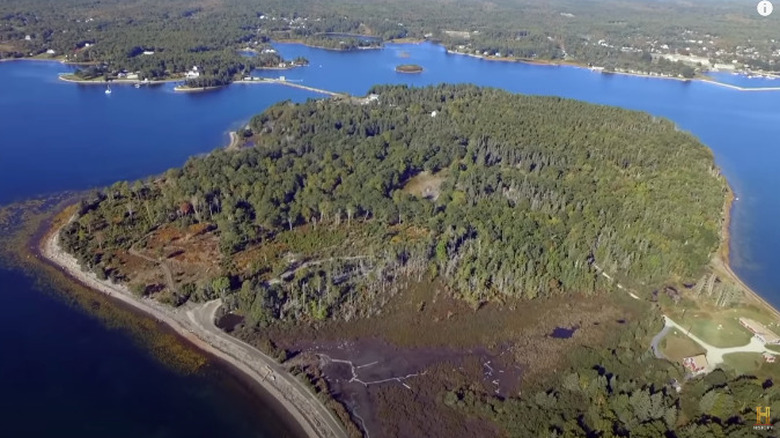Who Was The Curse Of Oak Island's Samuel Ball?
"The Curse of Oak Island" has introduced us to countless historical figures as the Lagina brothers have searched for the island's infamous treasure. Many –- like Captain Kidd, Marie Antoinette, and Sir Francis Drake –- are well-known to history. Other personalities encountered have been, unfortunately, unfairly, almost forgotten.
So it is with Samuel Ball. The name comes up most notably in Season 4, Episode 8 of "The Curse of Oak Island" (via IMDb), but his story seems to cast a large shadow over the series. It is speculated that he found the notoriously cursed treasure of Oak Island.
Of course, the mystery of Oak Island has spun out a great many theories. This seemingly constantly expanding list has by now grown to include not just the above names, but the Knights Templar, the Freemasons, and the Rosicrucians. And it's extremely unlikely that all of them are true. Nonetheless, in some ways, Samuel Ball's relative unknown status among these makes his own story even more fascinating.
Samuel Ball was an escaped slave
There are certain details that are known for sure. Born in 1764 or 1765 in South Carolina, Samuel Ball spent the first 11 years of his life in captivity and forced labor on a rice plantation. Given that Ball was born at a time when the slave trade was still very much legal and active in the 13 colonies, and wouldn't be legally or practically abolished in America for close to another century, this is not particularly surprising.
It's also not particularly surprising –- though certainly impressive –- that Ball escaped captivity at the age of 11. As the rebellions that would become the American Revolution began to stir, British military commanders offered enslaved people their freedom in return for fighting on the side of the crown. Ball was one of them.
After the war ended in America's victory, he relocated northwards, settling in Nova Scotia. This was a common destination for the people now known as Black Loyalists, former slaves who fought for the British during the American Revolution. Because what is now Canada was still under control of the British, it was a safe haven for the Black Loyalists, and tens of thousands arrived on ships after the war (via NovaScotia.ca).
He became the largest landowner on Oak Island
According to history writer Michael East, Samuel Ball settled on Oak Island in 1787. Eight years later, the famed Money Pit of Oak Island was discovered, and some unconfirmed accounts have Ball present at the discovery. In any event, he was well acquainted with those who discovered it in 1795, and by around 1810 would own the plot of land that included the Money Pit, along with several other plots. Indeed, he was the largest landowner on the island at that point.
How exactly Ball was able to purchase so much land isn't clear, though as East pointed out, land in the "New World" was still very cheap in this era, and not entirely out of reach for those of humble origins. Still, as Rosemary Godin of Nova Scotian news source Saltwire wrote, Ball was one of the richest people in the province by the time of his death in 1846. The source of his wealth is unknown, and it is unlikely that the life of a cabbage farmer, which is what most records recorded as his employment, was uniquely lucrative.
Furthermore, as East also wrote, there has been speculation that Ball had a connection to the mysterious "90-foot slab" reportedly found in the Money Pit. The rune-like lettering is very close to that used by loyalist prisoners, who used it to communicate encoded messages to each other during the Revolutionary War. This means that it very well could have been written by him, though this is difficult to verify given that the stone has long since disappeared to history.


